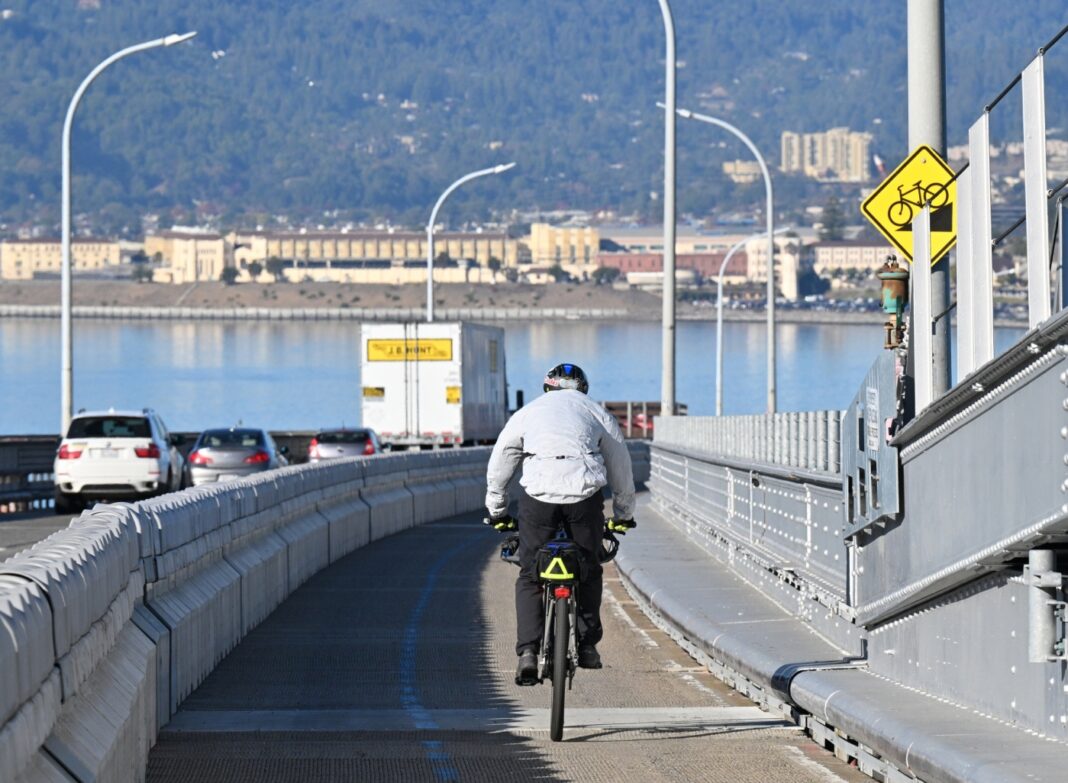Marin County’s state assemblyman, Bay Area business organizations and Richmond residents are calling on the state to use bridge toll revenues to reopen a third westbound lane on the Richmond-San Rafael Bridge to address air pollution impacts caused by traffic jams. The proposal comes as the state nears the end of a controversial, four-year pilot project that converted the bridge’s westbound emergency and maintenance lane into a bicycle and pedestrian path that is separated from vehicle traffic by a moveable barrier. Studies commissioned by the state have so far shown the bicycle path has had declining use but also no significant impacts on traffic congestion or vehicle accidents.
Assemblyman Damon Connolly and other supporters said the path should be reopened to vehicle traffic during the peak morning commute hours to address severe congestion on the Richmond side and alleviate the exhaust polluting neighboring communities. “It’s particularly important to listen to the local voices most impacted by the issues, and in this case that includes elevated levels of pollution caused by congestion that are impacting Richmond neighborhoods as well as well as traffic backups in the neighborhoods themselves,” Connolly said on Friday. “It’s really impacting teachers, construction workers, home health care workers — commuters who need to use the bridge to get to work.
” About 18,000 commuters cross the bridge on weekdays and can face about 20 minutes of additional travel time from traffic congestion during the morning westbound commute, according to legislation Connolly proposed this year. Proponents of the plan say they are not calling for ending bicycle and pedestrian access to the bridge. Connolly said the idea would be to add another moveable barrier on the bridge on the eastbound span, which currently has three lanes open to vehicle traffic.
For the morning commutes, cyclists would be diverted onto the lower deck to allow crews to reopen a third westbound lane, with the reverse happening during the afternoon commute in the eastbound direction. To fund this project, Connolly and supporters are calling on Caltrans and the Metropolitan Transportation Commission — the Bay Area’s top transportation planning agency — to use toll revenues collected from the seven state-owned bridges in the Bay Area, including the Richmond-San Rafael Bridge. The revenues come from voter-approved bridge toll hikes passed through Regional Measure 3 in 2018.
Connolly said that while there are specific projects to improve vehicle traffic conditions on the two ends of the bridge, such as the removal of the old toll booths on the Richmond side, the measure has more open-ended allocations that could be used to fund this project. The bicycle path pilot project is slated to end in November, with Connolly proposing that the two transportation agencies consider enacting the changes as part of a new pilot project. Supporters of the plan include Richmond neighborhood associations, Richmond City Council members, the Bay Area Council business association and the Richmond NAACP.
“By keeping the third lane of the upper deck closed to cars, we are forcing our community’s most vulnerable workers to sit through an extended commute,” Willie Robinson, president of the Richmond NAACP, said during a recent press conference on the proposal. “At the same time, we are polluting the air of the frontline communities living near the bridge approach with black carbon and nitrogen dioxide. ” Proponents cited a recent state-funded published by the Oakland-based PSE Healthy Energy nonprofit research institution that showed Richmond communities near Interstate 580 and Interstate 80 are experiencing significantly higher exposure to harmful pollutants linked to respiratory, cardiovascular and neurological diseases.
The proposal also comes after Connolly’s legislation, Assembly Bill 1464, which called for a similar solution, was held in the Assembly Appropriations Committee. Connolly said the bill will not be heard again this session but could be revisited next year. Local transportation planners say reopening the third westbound lane alone would not end traffic congestion issues on the bridge.
A study by the Transportation Authority of Marin — the state congestion management agency for the county — released in 2021 found that opening a third lane would shift the congestion from the Richmond Bridge toll plaza to Sir Francis Drake Boulevard, “thereby shifting a regional issue to a local issue. ” The agency is studying potential projects to improve traffic flow to and from the bridge, including an estimated $220 million direct connector between westbound I-580 and southbound Highway 101. Warren Wells, policy and planning director of the Marin County Bicycle Coalition, said that no matter what changes are considered for the bridge, his organization would want to see bicycle and pedestrian access maintained.
“While we are in complete agreement that the freeway traffic is a substantial source of pollutants in the city of Richmond, we question whether adding more capacity to the bridge would reduce pollution or worsen it,” Wells said. .
From: mercurynews
URL: https://www.mercurynews.com/2023/07/24/richmond-san-rafael-bridge-pollution-prompts-calls-for-lane-reopening/



